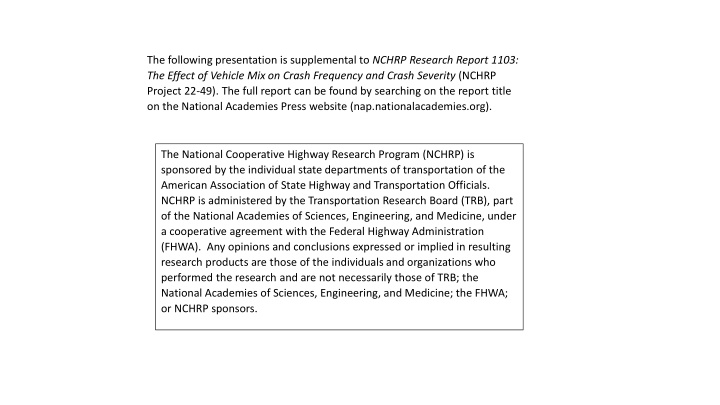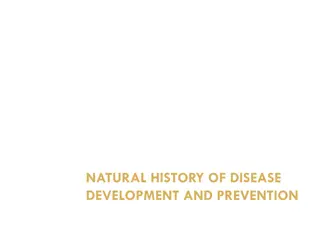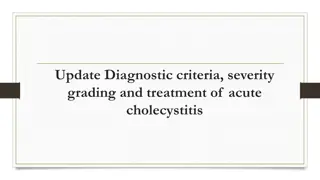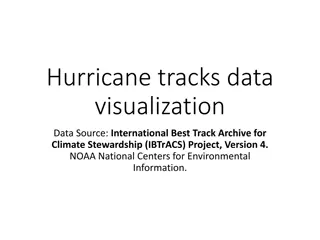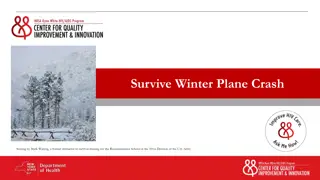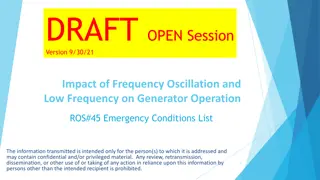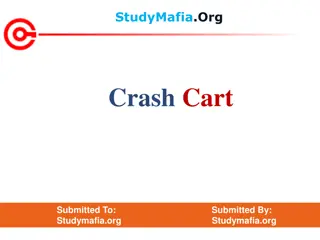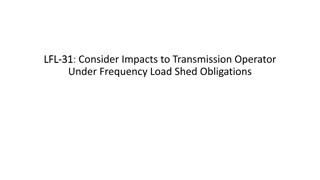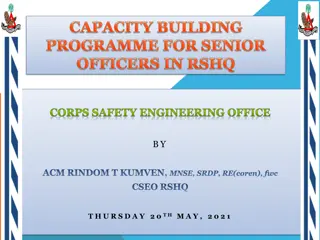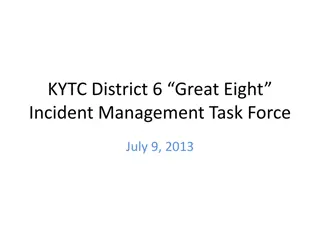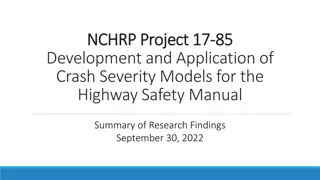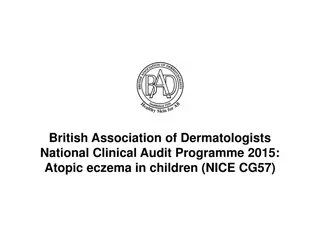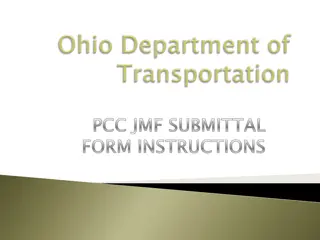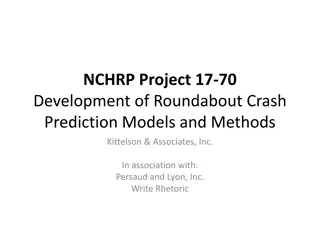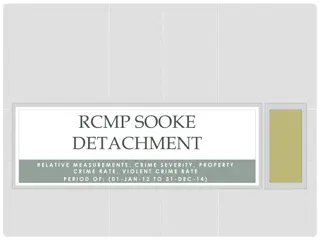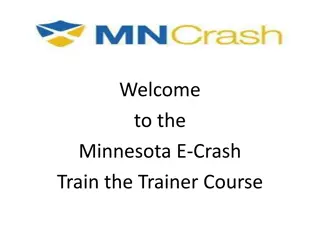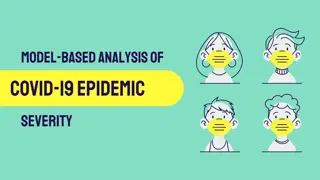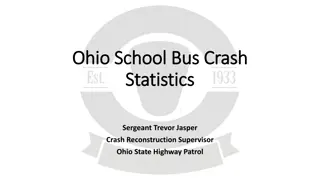Impact of Vehicle Mix on Crash Frequency and Severity
The supplemental presentation to NCHRP Research Report 1103 explores the influence of vehicle mix on crash frequency and severity. It highlights the project background, objectives, completed tasks, key deliverables, implementation strategies, and considerations for the Highway Safety Manual. The project team led by Naveen Eluru and Mohamed Abdel-Aty has developed crash models incorporating vehicle mix data to enhance crash prediction methods for better resource allocation. The report emphasizes the importance of integrating vehicle mix information in crash analysis and offers new approaches for future safety assessments.
Download Presentation

Please find below an Image/Link to download the presentation.
The content on the website is provided AS IS for your information and personal use only. It may not be sold, licensed, or shared on other websites without obtaining consent from the author.If you encounter any issues during the download, it is possible that the publisher has removed the file from their server.
You are allowed to download the files provided on this website for personal or commercial use, subject to the condition that they are used lawfully. All files are the property of their respective owners.
The content on the website is provided AS IS for your information and personal use only. It may not be sold, licensed, or shared on other websites without obtaining consent from the author.
E N D
Presentation Transcript
The following presentation is supplemental to NCHRP Research Report 1103: The Effect of Vehicle Mix on Crash Frequency and Crash Severity (NCHRP Project 22-49). The full report can be found by searching on the report title on the National Academies Press website (nap.nationalacademies.org). The National Cooperative Highway Research Program (NCHRP) is sponsored by the individual state departments of transportation of the American Association of State Highway and Transportation Officials. NCHRP is administered by the Transportation Research Board (TRB), part of the National Academies of Sciences, Engineering, and Medicine, under a cooperative agreement with the Federal Highway Administration (FHWA). Any opinions and conclusions expressed or implied in resulting research products are those of the individuals and organizations who performed the research and are not necessarily those of TRB; the National Academies of Sciences, Engineering, and Medicine; the FHWA; or NCHRP sponsors.
NCHRP Project 22-49 The Effect of Vehicle Mix on Crash Frequency and Crash Severity Project Final Presentation November 2023
Project Team Project Team Team Members Naveen Eluru (Principal Investigator) Mohamed Abdel-Aty Tanmoy Bhowmik Shahrior Pervaz Dewan Ashraful Parvez Lauren Hoover Kai Wang (Co-Principal Investigator) Shanshan Zhao Manmohan Joshi John N. Ivan Project Final Presentation 3
Outline Project Background and Objectives Project Tasks Completed Project Final Presentation Key Project Deliverables Project Implementation Future HSM Considerations 4
Project Background Highway Safety Manual (HSM) provides methods and procedures in estimating crashes at different levels. However, these methods currently do not account for the influence of vehicle mix information while model estimation. Project Final Presentation Recent research efforts show a substantial impact of vehicle mix on crashes. The incorporation of vehicle mix would improve crash predictive methods and assist in better use of the limited funds and resources. 5
Project Background The current project has explored the impact of vehicle mix on crash analysis. developed crash frequency and severity models for jurisdictions with vehicle mix data available by facility type. incorporated vehicle mix information in newer approaches. Project Final Presentation The newer approaches proposed have the advantage of being developed for recently completed NCHRP research (17-85) and would naturally lend themselves to modifying the HSM model structure for future versions. 6
Project Objectives (from RFP) Objective 1 Objective 2 Project Final Presentation Develop methods to quantify the effect of vehicle mix on crash frequency and severity for various facility types Develop a spreadsheet tool for practitioners to quantify the effect of vehicle mix on safety performance 7
Project Tasks Completed Phase I Task 1: Prepare a technical report that summarizes literature review, data availability, analytical approaches and develops a framework for incorporating vehicle mix in frequency and severity models Project Final Presentation Task 2: Develop a detailed work plan with data sources, selected facility types, data processing and analysis approaches, validation metrics and spreadsheet development Task 3: Prepare and submit an interim report 8
Project Tasks Completed Phase II Task 4: Apply the proposed framework by processing the data, estimating and validating models by facility type and examining model performance Project Final Presentation Task 5: Develop a spreadsheet tool clearly outlining the methodology and application guidance Task 6: Use practical examples, to test and illustrate the spreadsheet tool Task 7: Prepare an instruction guide and a quick start guide for facilitating adoption of the developed models 9
Project Tasks Completed Phase II Task 8: Provide a virtual demonstration for the NCHRP Panel as well as a final presentation to sponsoring committees including coordination with NCHRP and AASHTO Committee on Highway Traffic Safety Task 9: Prepare an accessible report with guidelines for future HSM adoption Task 10: Prepare draft final deliverables Task 11: Prepare documentation and guidance summarizing the research effort, future research recommendations, spreadsheet tools to enhance state DOTs procedures for updating crash frequency and severity models and a TR News article Project Final Presentation 10
Data Source California Connecticut Illinois Washington Non- HSIS South Dakota HSIS Florida Panel Meeting Minnesota Variables missing Ohio Texas Variables missing North Carolina 11
Facility Selection First, the team focused on the facilities that are covered in the first edition of the HSM rural two-lane two-way roadways, urban/suburban arterials, freeway segments and intersections Each facility is further categorized into multiple categories based on different variables (number of lanes, presence of median). Estimating models for all the facilities will require substantial amount of time and effort Vehicle mix might not vary across locations The research team focused on major facilities based on total and heavy vehicle crashes. rural multilane highways, Interim Panel Meeting 12
Facility Selection (Coarser Level) Segment Facilities Intersection Facilities Limited Access Facilities Rural Urban Interim Panel Meeting Arterials Urban Urban Rural Rural 13
Facility Selection (Finer Level) Segment Facilities Intersection Facilities Limited Access Facilities Rural Urban Interim Panel Meeting Arterials 3-leg STOP controlled 4-leg STOP controlled 3-leg signalized 4-leg signalized 4-lane divided 6-lane divided 8-lane divided 10-lane divided Urban Urban 2-lane undivided 3-lane 4-lane undivided 4-lane divided 5-lane 4-lane divided 6-lane divided 8-lane divided Rural Rural 3-leg STOP controlled 4-leg STOP controlled 4-leg signalized 14
Facility Selection: Detailed Classification Arterials: 1.Urban 2-LUD 2.Urban 3-L 3.Urban 4-LUD 4.Urban 4-LD 5.Urban 5-L 6.Rural 2-LUD 7.Rural 3-L 8.Rural 4-LUD 9.Rural 4-LD 10.Rural 5-L Limited Access Facilities: 1.Urban 4-LD 2.Urban 6-LD 3.Urban 8-LD 4.Urban 10-LD 5.Rural 4-LD 6.Rural 6-LD 7.Rural 8-LD 1.CA 2.CT 3.FL 4.IL 5.MN 6.TX 7.WA Segment Facility Facility Type Panel Meeting 1.CA 2.CT 3.FL 4.MN STOP Controlled: 1.Urban 3-leg 2.Urban 4-leg 3.Rural 3-leg 4.Rural 4-leg Intersection Facility Signalized: 1.Urban 3-leg 2.Urban 4-leg 3.Rural 4-leg 24 Facilities 15
Pooled Datasets Illinois Minnesota Florida Connecticut Texas Facility Type Pooled Data Panel Meeting Repeat process by facility type California Washington Validation Sample Estimation Sample 16
Variable Assessment Dependent Variables KABCO severity scale K (fatal crashes), A (incapacitating crashes), B (non-incapacitating crashes), C (possible injury crashes), and O (no injury crashes). Panel Meeting For intersection crashes - crashes that occurred within a 250ft intersection buffer are assigned. 17
Variable Assessment Independent Variables HSM aligned variables Roadway Characteristics Lane width, median width, shoulder width Traffic Characteristics AADT, major AADT, minor AADT New vehicle mix variables Coarser Level: %truck, %major road truck, %minor road truck Finer Level: %truck types (single unit, double unit etc.) Panel Meeting 18
Vehicle Mix Data Availability Vehicle Classification Vehicle Mix Data Availability Data Used for Models State Source Coarse Fine HSIS States Car Truck Car Truck Car Truck Car Truck -- Two axle, three axle, four axle, five axle -- Single unit, multi-unit -- Single unit, combination unit truck -- Single unit, double unit and triple unit California Available Observed CDOT Interim Panel Meeting Illinois Available Observed IDOT Minnesota Available Observed MNDOT Washington Available Observed WSDOT Non-HSIS States Connecticut Not AvailableCar -- -- -- -- -- Single unit, combination truck QIE technique Generated Truck Car Truck Car Truck Florida Available Observed FDOT 19 Texas Available Observed TXDOT
Approach and Assumptions of Vehicle Mix Data We employed state specific GIS data Developed approaches to match the nearest sections in GIS using proximity tools When data for the exact crash year was not available, AADT data for the crash year was employed along with the truck percentage from the nearest years (with an upper limit of 2years) to get truck AADT Panel Meeting For jurisdictions without any Truck data, we employed Quasi- induced Exposure method to generate data (for Connecticut) 20
Generating Vehicle Mix Data For Connecticut, we do not have information on vehicle mix We adopted the QIE approach to generate vehicle mix data Basic Idea: Proportion of a driver/vehicle category not at fault in two- or more-vehicle collisions is related to the exposure of that driver/vehicle category in the entire driving population at the location We aggregated nearby sites to get a large sample to estimate the proportions It allows us to accommodate vehicle information purely relying on crash data Further, the relative appropriateness of the approach can be easily evaluated Panel Meeting 21
Model Estimation with Truck Data Based on the data availability, we used following variables as vehicle mix data %truck: Truck AADT*100/AADT %SUT: Single unit truck AADT*100/AADT %major road truck: Truck AADT in major road*100/major road AADT %major road truck: Truck AADT in minor road*100/minor road AADT To consider additional forms of truck traffic affecting crash counts We tested for the impact of trucks in locations with high truck volume These are locations with truck proportion >= 85th Percentile of truck traffic proportion for the facility type For Rural Arterial 2 Lane Undivided (RA2LUD) segments, the high truck 85th percentile value was 20%. Panel Meeting 22
Model Frameworks Negative Binomial- Ordered Probit Fractional Split Model Multivariate Poisson- lognormal Model Project Final Presentation HSM Model Test and finalize SPF and SDF with vehicle mix variables 23
HSM Model HSM models were estimated and used as benchmark for comparison of the newly developed model systems in terms of data fit and predictive ability. Panel Meeting 24
Multivariate Count Method Total Crash 10 12 8 4 Injury 4 ID 1 2 3 4 PDO Fatal 6 6 5 0 0 1 1 5 2 3 1 Crash counts Panel Meeting Develop Multivariate Poisson Log-normal (MVPLN) model for crash severity levels at each facility type by severity level 25
Count Fractional Split Method Total Crash 10 12 8 4 Injury 0.4 0.42 0.25 0.75 Injury 4 ID 1 2 3 4 PDO Fatal PDO 0.6 0.5 0.63 Fatal 6 6 5 0 0 1 1 0 5 2 3 0.08 0.12 0.25 1 0 NB Model Ordered Fractional Split Model Panel Meeting Predicted Severity Proportions X Predicted Total Crash Counts Predicted Severity Counts 26
Calibration of NB-OPFS Model Models were developed considering 7 States for segment facilities (CA, CT, FL, IL, MN, TX, WA), and 4 States for intersection facilities (CA, CT, FL, MN) Calibration is recommended for other states Calibration factor for severity S, ????????????????? ???? ?? ??? ? ? ???????? ????? ? ?????????????????? ???? ?? ??? ? ? ???????? ????? ? ??? ????,?= Panel Meeting Calibrated predicted crashes for severity S, ????? ,?= ????? ,? ??? ???? where ????? ,?= predicted number of crashes for severity level S 27
Calibration of MVPLN Model Models were developed considering 7 States for segment facilities (CA, CT, FL, IL, MN, TX, WA), and 4 States for intersection facilities (CA, CT, FL, MN) Calibration is recommended for other states Calibration factor for severity S, ????????????????? ???? ?? ??? ? ? ???????? ????? ? ?????????????????? ???? ?? ??? ? ? ???????? ????? ? ?MVPLN,?= Panel Meeting Calibrated predicted crashes for severity S, ????? ,?= ????? ,? ?????? where ????? ,?= predicted number of crashes for severity level S 28
Model Selection Use of mean square error and predictive error We employed two different measures of fit: Mean Absolute Deviation (MAD) MAD = ???? | ?? ??| where ?? = Predicted crashes, ?? = Observed crashes, at space i over a period of time. Mean Squared Prediction Error (MSPE) Panel Meeting 2 MSPE = ???? ?? ?? The smaller the value, the better the model predicts observed crashes. 29
Model Selection Process For each facility type: 3 Models HSM Multivariate Poisson Lognormal Negative Binomial Fractional Split Identifying the best modelis challenging 20 dimensions are compared (2*2*5) It is unlikely: single model outperforms across all 20 measures For each model: 2 Performance measures MAD MSPE Panel Meeting MAD and MSPE 2 samples: estimation and validation For all 5 severity (KABCO) categories 30
Model Selection Process Hence, we considered 2 approaches The first approach employs total crash frequency model that performs better in predicting total crash counts for both samples (estimation and validation) The second approach employs a scoring process where the models that perform well for the severity levels are awarded a point and the score for each model across the severity levels is aggregated. The final selection is considered based on 2 approaches Panel Meeting 31
Model Selection Process Facility Group Selected by MSPE NB-OPFS HSM HSM NB-OPFS/HSM NB-OPFS/HSM HSM HSM NB-OPFS/MVPLN NB-OPFS/HSM NB-OPFS/HSM NB-OPFS NB-OPFS NB-OPFS NB-OPFS NB-OPFS/MVPLN NB-OPFS NB-OPFS Selected for Facility NB-OPFS HSM HSM HSM HSM HSM HSM NB-OPFS NB-OPFS/HSM HSM NB-OPFS NB-OPFS NB-OPFS NB-OPFS MVPLN NB-OPFS NB-OPFS Recommended for Facility Group Scenario 1 Facility Selected by MAD ULA4LD ULA6LD ULA8LD ULA10LD RLA4LD RLA6LD RLA8LD UA2LUD UA3L UA5L UA4LUD UA4LD RA2LUD RA3L RA5L RA4LUD RA4LD NB-OPFS HSM HSM HSM HSM HSM HSM NB-OPFS/HSM NB-OPFS/HSM NB-OPFS/HSM NB-OPFS/HSM NB-OPFS/HSM NB-OPFS/MVPLN NB-OPFS MVPLN NB-OPFS/HSM NB-OPFS/HSM Urban Limited Access HSM Scenario 2 Rural Limited Access HSM Scenario 3 Urban Arterials Panel Meeting NB-OPFS If 2 different models are selected based on the 2 approaches, both models are considered. Rural Arterials NB-OPFS 32
Model Selection for Facility Group Facility Group Selected by MSPE NB-OPFS HSM HSM NB-OPFS/HSM NB-OPFS/HSM HSM HSM NB-OPFS/MVPLN NB-OPFS/HSM NB-OPFS/HSM NB-OPFS NB-OPFS NB-OPFS NB-OPFS NB-OPFS/MVPLN NB-OPFS NB-OPFS Selected for Facility NB-OPFS HSM HSM HSM HSM HSM HSM NB-OPFS NB-OPFS/HSM HSM NB-OPFS NB-OPFS NB-OPFS NB-OPFS MVPLN NB-OPFS NB-OPFS Recommended for Facility Group NB-OPFS Facility Selected by MAD ULA4LD ULA6LD ULA8LD ULA10LD RLA4LD RLA6LD RLA8LD UA2LUD UA3L UA5L UA4LUD UA4LD RA2LUD RA3L RA5L RA4LUD RA4LD NB-OPFS HSM HSM HSM HSM HSM HSM NB-OPFS/HSM NB-OPFS/HSM NB-OPFS/HSM NB-OPFS/HSM NB-OPFS/HSM NB-OPFS/MVPLN NB-OPFS MVPLN NB-OPFS/HSM NB-OPFS/HSM Urban Limited Access HSM Rural Limited Access HSM Urban Arterials Panel Meeting NB-OPFS Rural Arterials NB-OPFS 33
Model Selection for Facility Group Recommended for Facility Group Facility Group Selected by MAD Selected by MSPE Selected for Facility Facility NB- NB- NB- U3ST OPFS/MVPLN OPFS/MVPLN NB- OPFS/MVPLN MVPLN NB- OPFS/MVPLN NB-OPFS NB- OPFS/MVPLN OPFS/MVPLN Urban Intersections U4ST MVPLN MVPLN MVPLN U3SG MVPLN MVPLN U4SG MVPLN MVPLN R3ST NB-OPFS NB-OPFS Panel Meeting Rural R4ST MVPLN MVPLN NB-OPFS Intersections NB- R4SG NB-OPFS NB-OPFS OPFS/MVPLN 34
Model Recommendations for Segment Facilities Recommended for Facility Group NB-OPFS Facility Group Facility Urban 4-lane divided (ULA4LD) Urban 6-lane divided (ULA6LD) Urban 8-lane divided (ULA8LD) Urban 10-lane divided (ULA10LD) Rural 4-lane divided (RLA4LD) Rural 6-lane divided (RLA6LD) Rural 8-lane divided (RLA8LD) Urban 2-lane undivided (UA2LUD) Urban 3-lane (UA3L) Urban 5-lane (UA5L) Urban 4-lane undivided (UA4LUD) Urban 4-lane divided (UA4LD) Rural 2-lane undivided (RA2LUD) Rural 3-lane (RA3L) Rural 5-lane (RA5L) Rural 4-lane undivided (RA4LUD) Rural 4-lane divided (RA4LD) Urban Limited Access HSM Project Final Presentation Rural Limited Access HSM Urban Arterials NB-OPFS Rural Arterials NB-OPFS 35
Model Recommendations for Intersection Facilities Recommended for Facility Group Facility Group Facility Urban 3-leg STOP controlled (U3ST) Urban 4-leg STOP controlled (U4ST) Urban 3-leg signalized (U3SG) Urban 4-leg signalized (U4SG) Rural 3-leg STOP controlled (R3ST) Rural 4-leg STOP controlled (R4ST) Rural 4-leg signalized (R4SG) Project Final Presentation Urban Intersections MVPLN Rural NB-OPFS Intersections 36
Final Report Chapter 6: Model Parameters Descriptive statistics/variable ranges of the facility Model estimation results Project Final Presentation Model equations Model estimation results with t- statistics (Appendix) Model performance measures (Appendix) Elasticity (Appendix) 37
Excel Spreadsheet Tools To aid the practitioners in implementing the new models the research team developed three excel spreadsheet tools including: 22-49 Spreadsheet Tool without Calibration, 22-49 Spreadsheet Tool with Calibration, and 22-49 Data Input and Prediction Tool Project Final Presentation 38
Excel Spreadsheet Tools 22-49 Spreadsheet Tool without Calibration: Provides predictions for the user provided data directly without considering calibration. Project Final Presentation 39
Excel Spreadsheet Tools 22-49 Spreadsheet Tool with Calibration: Provides predictions for the user provided data while modifying the predictions considering calibration. Project Final Presentation 40
Excel Spreadsheet Tools 22-49 Data Input and Prediction Tool: Provides practitioners a tool to undertake crash frequency and severity analysis at a facility resolution (segment and intersection). Project Final Presentation 41
Spreadsheet Tool User Guide Project Final Presentation The step-by-step guidelines to use spreadsheet tools has been submitted. Guidelines contains detailed instructions for three developed tools. 42
Thank you Project Final Presentation 43
